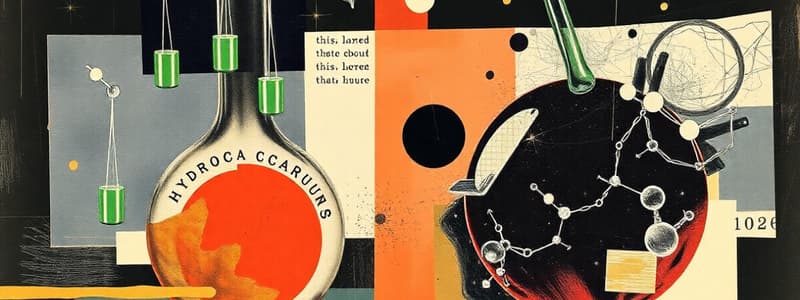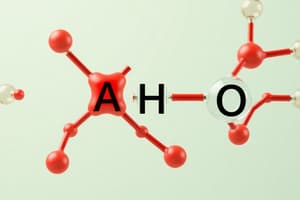Podcast
Questions and Answers
What is the process called where higher alkanes are converted into lower alkanes?
What is the process called where higher alkanes are converted into lower alkanes?
- Cracking (correct)
- Isomerization
- Dehydration
- Hydrogenation
What reagent is used to reduce a double bond in an alkene?
What reagent is used to reduce a double bond in an alkene?
- H<sub>2</sub>/Pt
- H<sub>2</sub>/Ni (correct)
- HBr
- H<sub>2</sub>O/H<sup>+</sup>
Which statement correctly describes the stability of alkenes based on the number of alpha-hydrogens?
Which statement correctly describes the stability of alkenes based on the number of alpha-hydrogens?
- Stability is independent of the number of alpha-hydrogens.
- Stability is directly proportional to the number of alpha-hydrogens. (correct)
- Stability is inversely proportional to the number of alpha-hydrogens. (correct)
- Stability is unaffected by the number of alpha-hydrogens.
What is the role of the W.K.R and C.R. reagents in converting a carbonyl group into a methylene group?
What is the role of the W.K.R and C.R. reagents in converting a carbonyl group into a methylene group?
Which of the following is a characteristic of an aromatic fouler?
Which of the following is a characteristic of an aromatic fouler?
Flashcards
Cracking
Cracking
The process of converting higher alkanes into lower alkanes.
Hydrogenation
Hydrogenation
The process of adding hydrogen to a double bond, reducing it.
Stability of Alkenes
Stability of Alkenes
Stability of an alkene is directly proportional to the number of alpha-hydrogens.
W.K.R and C.R
W.K.R and C.R
Signup and view all the flashcards
Lindlar Catalyst
Lindlar Catalyst
Signup and view all the flashcards
Study Notes
Hydrocarbon Reactions
-
Pyrolysis/Cracking: Higher alkanes are converted into lower alkanes through a process called pyrolysis or cracking.
-
Hydrogenation: Double bonds are reduced by hydrogenation, typically using hydrogen (H₂) and a catalyst like nickel (Ni).
-
Stability of Alkenes: The stability of alkenes is directly proportional to the number of alkyl groups attached to the double bond.
Alkane Properties
-
Structural Isomers: Different structural arrangements of the same molecular formula (e.g., different branches of an alkane).
-
Branching: The presence of branches on a carbon chain affects properties such as boiling point and density (branched alkanes generally have lower boiling points). This is significant for comparing properties during reactions.
Additional Reactions
-
Chlorination/Bromination: Chlorination and bromination of alkanes can form various mono-substituted products. The reaction produces only one single type of product in each scenario.
-
Combustion: Alkanes undergo complete combustion in the presence of oxygen (O₂) to produce carbon dioxide (CO₂) and water (H₂O).
-
Alkene Formation: Alkenes can be generated by removing hydrogen from alkanes
-
Isomerization: Conversion of one isomer to another, like converting n-butane to 2-methylpropane.
Other Concepts
- Enantiomers: Enantiomers, mirror image isomers, are distinct compounds and can't be separated by fractional distillation.
- Cis-trans isomers: Cis and trans isomers exist because the rotation around a carbon-carbon double bond is hindered. This affects the placement of substituents relative to the bond axis.
- Aromatic Compounds: Aromatic compounds are cyclic, planar molecules that possess delocalized sigma and pi bonds, influencing their chemical reactivity compared to other ring compounds.
- Iodination of alkanes : Iodination of alkanes is a reversible process.
Studying That Suits You
Use AI to generate personalized quizzes and flashcards to suit your learning preferences.




